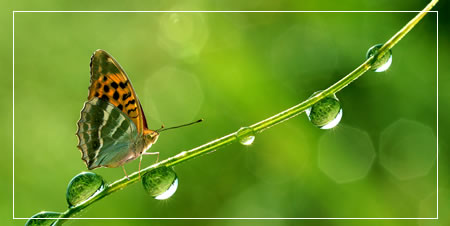 BUTTERFLY EDUCATION - Butterflies of Ireland
BUTTERFLY EDUCATION - Butterflies of Ireland
In addition to the information on this site there is an excellent publication by Jesmond Harding titled “Discovering Irish Butterflies and their Habitats”.
Copies signed by the author are available at the Straffan Butterfly Farm Gift Shop.
Also there is a very good butterfly website created by Adrian Phelan which gives further information and location maps for all of the Irish butterflies. You will find this at www.irishbutterflies.com
If you are interested in assisting with compiling Irish Butterfly Records you will find further information on the Dublin Naturalists Field Club website – www.butterflyireland.com

Butterflies of Ireland (in alphabetical order)
If you have a photo of any of the Irish Butterflies you would like to share, please email us at info@straffanbutterfly.com and we will credit you for the photo.
| Brimstone - gonepteryx rhamni Early entomologists knew this species as the 'Butter Coloured Fly' and it is thought that this gave rise to the word Butterfly. The Brimstone breeds in Ireland only where the larval food plant Buckthorn grows and this is generally around Lough Ree, Lough Derg and some of the lakes in Co. Clare. The butterfly hybernates,is single brooded and can be seen on the wing from March until October. |
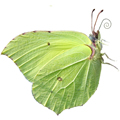 |
| Brown Hairstreak - thecla betulae This butterfly is one of the rarest in Ireland and is confined to south Galway and north Clare. The eggs are laid singly on blackthorn which is the larval food plant and the butterfly flies during the month of August. It is a single brooded species. |
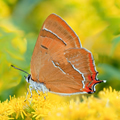 |
Clouded Yellow - Colias croceus |
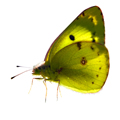 |
| Back to Top ^ | |
| Common Blue - polyommatus icarus This pretty butterfly is common and widespread throughout Ireland along canal banks, overgrown quarries and sand dunes. It is active in sunshine but during dull weather it rests on grass stems with its wings closed and is not easily seen. The eggs are laid singly on Birds Foot Trefoil which is the larval food plant and it is generally double brooded. |
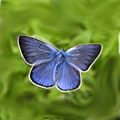 |
| Dark Green Fritillary - argynnis aglaja This species is mostly confined to the coastal areas of Ireland but nowhere is it common. It is a strong and fast flier the best way to see one is to approach quietly when the butterfly is busy taking nectar from Thistles. The eggs are laid singly on Dog Violet which is the larval food plant and the butterfly can be seen flying during July and August. It is single brooded. |
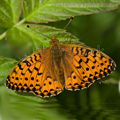 |
Dingy Skipper - erynnis tages |
No Photo Available |
| Back to Top ^ | |
| Gatekeeper - Maniola tithonus This species is only found on the warmer southern and eastern coasts south of a line from Dublin to Limerick. The Butterfly can be seen basking with it's wings open and flies during July and August. The eggs are laid on common grasses which are the larval food plant and it is a single brooded species. |
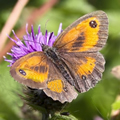 |
| Grayling - hipparchia semele This butterfly is locally common in coastal regions of Ireland and can be seen in areas such as sand dunes. There are colonies in some inland limestone areas and a distinct subspecies (clarensis) exists in the Burren, Co.Clare and Connemara,Co.Galway. The flight is swift but short and as soon as the butterfly settles it closes its wings and lowers the forewings between the hindwings. It then leans over seemingly to avoid casting a shadow and is very difficult to find until it is disturbed and flys away. The eggs are laid singly on common grasses which are the larval food plant and the butterfly is on the wing from July to September. It is a single brooded species. |
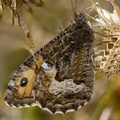 |
Green Hairstreak - callophrys rubi |
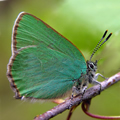 |
| Back to Top ^ | |
| Green Veined
White - pieris napi This species is common throughout Ireland and can sometimes be seen in great numbers in damp or marshy fields. The eggs are laid singly on wild Brassicas which are the larval food plant and the butterfly can be seen from April until August. It is a double brooded species. |
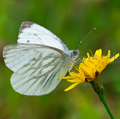 |
| Holly Blue - celastrina argiolus This species is on the increase in Ireland and is generally found where holly occurs as an understorey in woodland. It is the only butterfly whose food plant changes with the seasons as the Spring brood lays its eggs on holly but the Autumn brood lays its eggs on ivy. |
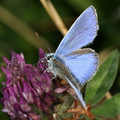 |
Large Heath - coenonypha tullia |
No Photo Available |
| Back to Top ^ | |
| Large White - pieris brassicae This butterfly is common throughout Ireland and is known to gardeners as the Cabbage White. It is not as common as it used to be which is probably due to increased garden sprays. The eggs are laid in batches on the cabbage leaves and the butterfly can be seen on the wing from May to September. It is generally double brooded. |
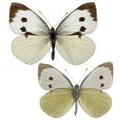 |
| Marsh Fritillary - eurodryas aurinia This butterfly is uncommon and very local in Ireland. It will only be found near meadows or marshy ground where the larval food plant Devils Bit Scabious grows. The eggs are laid in batches on the underside of leaves and after emergence the larvae spin a large web on the ground and dozens of them hibernate inside until the Spring comes. The butterfly is on the wing during late May and June and it is single brooded. |
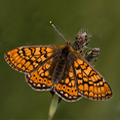 |
Meadow Brown - Maniola jurtina |
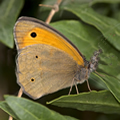 |
| Back to Top ^ | |
| Orange Tip - anthocharis cardamines This lovely little butterfly is common along the hedgerows and marshy fields all over Ireland. Only the male has the orange band which gives this species its name. The eggs are bright orange and are shaped like skittles. They are laid singly on Garlic Mustard which is the larval food plant. The butterfly is on the wing during May and June. It is a single brooded species. |
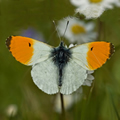 |
| Painted Lady - Cynthia cardui This is a migrant butterfly which flies to Ireland from Southern Europe and North Africa. It lays its eggs singly on Thistles which are the larval food plant and several generations are produced during the Summer. However they are unable to survive the damp Irish Winter and die out only to be replaced by fresh migrants the following year. |
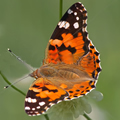 |
Peacock - inachis io |
 |
| Back to Top ^ | |
| Pearl Bordered
Fritillary - boloria euphrosyne This is the rarest butterfly in Ireland and is only found in the Burren, Co. Clare. The flight is fast and gliding and the butterfly can sometimes be seen close up when it is basking on warm limestone or feeding from flowers. The eggs are laid singly on or near the food plant which is Dog Violet and the butterfly is on the wing during May and June. |
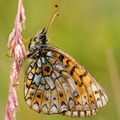 |
| Purple Hairstreak - quercusia quercus This is another of our rarest species being only found in established Oakwoods throughout Ireland. Eggs are laid singly, close to a bud or in a fork of the Oak branch and the butterfly can be seen flying near the treetops during the month of August. It is single brooded. |
No Photo Available |
Red Admiral - Vanessa atalanta |
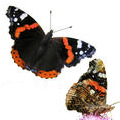 |
| Back to Top ^ | |
| Ringlet - aphantopus hyperantus This almost black butterfly is common throughout Ireland and is generally found in the same areas as the Meadow Brown. It is a restless butterfly and takes frequent but short flights and seems to prefer shady areas. The eggs are scattered freely amongst the grasses which are the larval food plant and the butterfly can be seen from June to August. It is single brooded. |
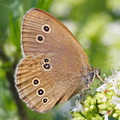 |
| Silver Washed
Fritillary - argynnis paphia This magnificent butterfly is the largest of the Irish Butterflies and is locally common throughout Ireland. It is a sun loving species with a fast flight and can usually be seen in woodland clearings where it will visit bramble flowers for nectar. The eggs are laid singly on the bark of trees near to where Dog Violet is growing as this is the larval food plant. It is a single brooded species. |
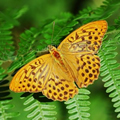 |
Small Blue - cupido minimus |
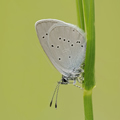 |
| Back to Top ^ | |
| Small Copper - lycaena phlaeas This fiery little butterfly is common and widespread throughout Ireland. It is a territorial species and generally has a favourite flower or resting spot from which it will flit to pursue any other passing butterfly. The eggs are laid singly on dock or sorrel which are the larval food plant and 3 broods are produced most years. |
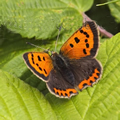 |
| Small Heath - coenonympha pamphilus This small butterfly is common throughout Ireland and can be seen resting with its wings closed in grassy locations and embankments. The eggs are laid singly on common grasses which are the larval food plant. The butterfly can be seen from May to September. It is double brooded. |
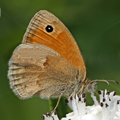 |
Small Tortoiseshell - aglias urticae |
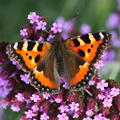 |
| Back to Top ^ | |
| Small White - pieris rapae This butterfly is common throughout Ireland and can also be classed as a 'Cabbage White' . The eggs are laid singly on Nasturtium and Cabbage and the butterfly flies from April to August. It produces two broods and sometimes manages a third during favourable weather. |
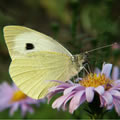 |
| Speckled Wood - Pararge aegeria This pretty butterfly is common throughout Ireland and is found in woodland clearings and along hedgerows but prefers shady spots or dappled sunlight. The eggs are laid singly on common grasses which are the larval food plant and the butterfly can be seen flying from May to September. It is generally double brooded. |
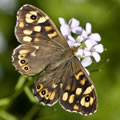 |
Wall Brown - Pararge megera |
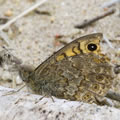 |
| Wood White - leptidia sinapis This species is found throughout Ireland although is never common in any area. It has a weak and feeble flight and is only active in sunshine. The eggs are laid singly on Wetch and Birdsfoot Trefiol which are the larval food plant and it can be seen on the wing from May until August. It is generally a double brooded species. |
No Photo Available |
| Back to Top ^ |
